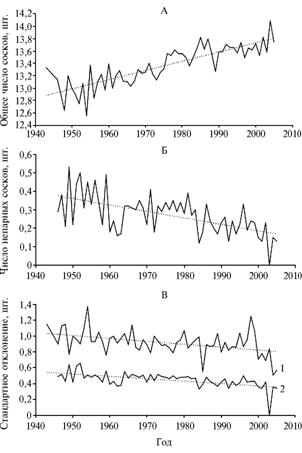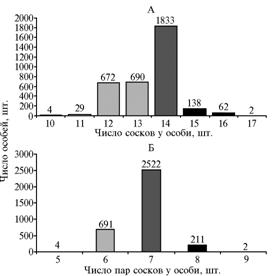УДК 636.4:575.174.4:591.4
NUMBER AND SYMMETRY OF NIPPLES IN THE PIGS AS PARAMETERS OF A STABLE DEVELOPMENT OF POPULATION
S.P. Knyazev1, S.V. Nikitin2, T.I. Schwebel1
The authors investigated the long-term processes in the changes of the number and the symmetry of nipples in the pigs in main population of Kemerovskaya breed from «Yurginskii» pedigree farm. The analysis was shown, that natural and artificial selection of individuals with stable development have in population the primary meaning for an increasing of average number of nipples.
Key words: pigs, Kemerovo breed, populations, ontogenesis, number of nipples.
The number of nipples in domestic pigs varies from 5 to 9 pairs, one or two of which may be incomplete (1). Presence of incomplete of pairs of nipples reflects the degree of stability of population development in certain environmental conditions. This stability is provided by the balance of gene complexes, which are destructed at the crossing of forms adapted to different environmental conditions (2). The Kemerovskaya breed of pigs was obtained by crossing the native Siberian pigs with the farm breeds of different productivity directions (3).
The purpose of the study was to analyze the long-term changes in number and location of nipples in pigs of the main population the Kemerovskaya breed and to identify the key genetic component in this process.
Methods. The study was performed upon the data of zootechnical accounts of 3427 pigs the Kemerovskaya breed, born and kept at the “Yurginskij” pedigree plant (Yurginskij district, Kemerovo region.) in 1943 - 2005. The dynamics of changes in number and location of nipples in main population were estimated by the averages of parameters "total number of nipples" and "number of unpaired nipples in an individual. The parameter "number of pairs of nipples” was used isolate the phenotypic classes.
Statistical processing of data was performed by standard methods (4). Reliability of systematic fluctuations of averages and standard deviations of the studied parameters were assessed using the coefficient of correlation (r) between the selective criterion of parameter and year of birth of individuals from the test group. The genetic components affecting formation of features were revealed using variance analysis.
Results. In 1943-2005, in the "Yurginskij" pedigree farm population of pigs, the total number of nipples was increasing uniformly and statistically significantly, while the number of unpaired nipples was decreasing (Fig. 1). Both processes were accompanied with the uniform statistically significant decrease in standard deviation of each of two parameters and the almost parallel trend lines of standard deviations. In general, the observed changes indicate the only one long-term process in population – the reduction of average number of unpaired nipples due to selection of pedigree phenotypes with a stable development in ontogenesis. As a result, the total number of nipples in the following generations was increasing.
 |
Fig. 1. Dynamics of changes in total number of nipples (A; r = +0,83, P <0,001), in number of unpaired nipples (B; r = -0,47, P <0,001) and in standard deviations of the first (1) and second (2) parameters (B;, r = -0,43, P <0,001 and r = -0,33, P <0,01, resp.) in the population of pigs the Kemerovskaya breed (the pedigree farm "Yurginskij”, Yurginskij district, Kemerovo region., 1943 -2005). Explanations: |
Figure 2 shows the distribution of individuals by total number of nipples and by number of pairs of nipples in a sample group, comprising animals of all years of birth for the entire studied period. According the charts, there are two modal classes - individuals with number of nipples equal to 14 (53.44%), and individuals with seven pairs of nipples (73.53%).
So, seven complete pairs of nipples is the norm for Kemerovo pigs. The proportion of individuals with number of nipples less than 14 was 40.67%, less than seven pairs - 20.26%. The least contribution in phenotypic diversity of populations was provided by individuals with number of nipples over 14 (5,89%), and with number of pairs of nipples over 7 (6.21%). The observed variability in the population is mainly formed by the genes that determine partial or complete reduction of individual pairs of nipples. Genes determining formation of additional of pairs of nipples are playing the significantly less role.
In the studied population, three main classes of individuals were identified: with number of pairs of nipples, equal to 7 (the number of nipples 13-14), less than 7 (the number of nipples 10-12) and more than 7 (the number of nipples 15-18). Three variance complexes were formed, each one included three types of crosses of individuals with different number of pairs of nipples in boars and sows (Table).
The variance analysis of crosses in which one partner had seven pairs of nipples, and another - seven, more or less number of pairs of nipples (complex № 1) showed that the offspring was significantly distinct in number of nipples and in total number of pairs of nipples, while differences in number of incomplete pairs were statistically insignificant. The correlation between the number of pairs of nipples in parents and the number of nipples and pairs of nipples in offspring was observed.
In crosses when one partner had the number of pairs of nipples less than 7 (complex № 2), F1 generation was significantly distinct in number of unpaired nipples; differences in two other parameters were negligible. The more pairs of nipples had the second parent, the less number of incomplete pairs were observed in progeny. In crosses of individuals having the number of pairs of nipples more than 7 with animals having the different number of pairs (complex № 3), no reliable distinction between the descendants was observed, which allowed to compile them in one group (the bottom row of the table).
 |
Fig. 2. Distribution of individuals in the population of pigs the Kemerovskaya breed by number of nipples (A) and by number of pairs of nipples (B) (the pedigree farm "Yurginskij”, Yurginskij district, Kemerovo region., 1943 -2005). Explanations: |
The results of variance analysis have revealed, that number and location of the nipples in the studied population are determined by alleles of two groups of genes. The optimal "background" value of the feature (seven complete pairs of nipples) is obviously determined by the "initial", non-mutant type of alleles.
Complete or partial reduction of individual pairs of nipples is under control of the previously described group of genes (5), recessive mutations of which disrupt the formation of mammary glands. Genes, providing formation of additional pairs of nipples, were discovered in early last century (1). In the studied population of pigs the Kemerovskaya breed, there are at least two such genes, since the number of pairs of nipples can increase to 8 or 9.
Results of variance analysis of crosses of individuals with different number of pairs of nipples in pigs the Kemerovskaya breed (the pedigree farm "Yurginskij", Yurginskij district, Kemerovo region., 1943-2005). |
|||||||||||
Type of crossing |
Number of descendants |
Number of nipples, M±m |
Number of pairs of nipples,
|
||||||||
Total |
Incomplete
|
||||||||||
Complex № 1 |
{n < 7} х {n = 7} |
775 |
13,36±0,03 |
6,81±0,02 |
0,25±0,02
|
||||||
{n = 7} х {n = 7} |
1328 |
13,51±0,03 |
6,88±0,01 |
0,26±0,01
|
|||||||
{n = 7} х { n > 7} |
273 |
13,77±0,06 |
7,00±0,03 |
0,23±0,03 |
|||||||
F (d.f.1 = 2, d.f.2 = 2373) |
20,123*** |
16,469*** |
0,405нд |
||||||||
Complex № 2 |
{n < 7} х {n < 7} |
118 |
13,43±0,08 |
6,88±0,04 |
0,33±0,05
|
||||||
{n < 7} х {n = 7} |
775 |
13,36±0,03 |
6,81±0,02 |
0,25±0,02 |
|||||||
{n < 7} х {n > 7} |
57 |
13,65±0,12 |
6,88±0,06 |
0,11±0,04 |
|||||||
F (d.f.1= 2, d.f.2 = 947) |
2,743нд |
1,581нд |
4,904** |
||||||||
Complex № 3 |
{n < 7} х {n > 7} |
57 |
13,65±0,12 |
6,88±0,06 |
0,11±0,04
|
||||||
{n = 7} х {n > 7} |
273 |
13,77±0,06 |
7,00±0,03 |
0,23±0,03 |
|||||||
{n > 7} ´ {n > 7} |
7 |
13,71±0,18 |
7,00±0,00 |
0,29±0,18 |
|||||||
F (d.f.1 = 2, d.f.2 = 334) |
0,370нд |
1,353нд |
2,284нд |
||||||||
Total for complex № 3 |
337 |
13,75±0,05 |
6,98±0,03 |
0,21±0,02
|
|||||||
Note:
n - number of pairs of nipples, F - Fisher criterion, d.f.1 and d.f.2 - the first and second degrees of freedom, resp. |
|||||||||||
The reason for the occurring changes in population was the selection including several components: the artificial selection on increase in number of nipples, systematically kept in the pedigree farm "Yurginskij"; the artificial selection with the purpose to obtain the hereditarily homogeneous high productive pigs corresponding to the breed type and set of parameters recommended by the "Instructions for bonitation of pigs" (6), as well as culling of animals with less than 6 pairs of nipples, and the natural selection of individuals with stable development in ontogenesis to form the balanced sets of adaptive genes.
The artificial selection for number of nipples provides the relatively insignificant contribution into the observed long-term changes, because it was held upon the animals passing strict selection for key characteristics of productivity. The animals with higher numbers of nipples had the advantage at the selection of the main breeding population only among the individuals with the equal standard set of main economically important features, primarily - in meat and fattening productivity.
The selection for number of nipples is just the complementary way of natural and artificial selection of individuals with stable development and not prone to bilateral asymmetry including reduction of nipples. These processes result in the increase of average number of nipples due to decrease in average number of unpaired nipples. The importance of artificial selection for number of nipples, are apparently related to the selection into the main pedigree group of animals with additional pairs of nipples.
Thus, both artificial and natural selection of individuals with stable development resulted in decrease of frequency of mutations that cause partial or complete reduction of pairs of nipples. Selection was the major driving force in increase of average number of nipples in the population of pigs the Kemerovskaya breed, obtained by crossing the forms contrasting in many parameters.
REFERENCES
1. Volkop’yalov B.P., Lyus Ya.Ya., Shul’zhenko I.F. e.a., Porody, genetika i selektsiya svinej (Breeds, Genetics and Selection of Swain), Moscow - Leningrad, 1934.
2. Zakharov V.M., Phenogenetic Aspects of Investigation of Natural Populations, in Phenetika populatsij (Population Phenetics), Мoscow, 1982, pp. 45-55.
3. Gudilin I.I., Dement’ev V.N. e.a., Kemerovskaya poroda svinej (The Kemerovskaya Breed of Pigs), Novosibirsk, 2003.
4. Lakin G.F., Biometriya (Biometry), Мoscow, 1990.
5. Danil’chenko N.V., Knyazev S.P., Faddeyeva N.S. e.a., Genetically Determined Asymmetry of Nipples in Domestic Pigs, Zh. S.-ch. Biol., 2002, no.2, pp. 29-32.
6. Instruktsya po bonitirovke svinej (Guidelines on Bonitation of Pigs, by General Directorate of Livestock (with the State Inspectorate on Pedigree Breeding), Мoscow, 1978.
1Novosibirsk State Agrarian University, Novosibirsk 630039, Russia |
Received |













